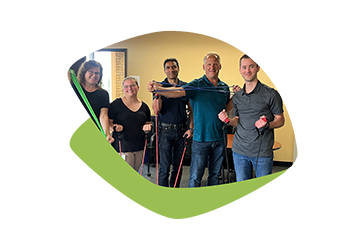Tackling public sector health challenges with onsite wellness programs


Five ways onsite wellness program management boosts employee health and engagement
Working in the public sector industry can be rewarding, but it comes with unique challenges. Public sector employees perform critical roles in local government agencies, from administration to public safety and public works to planning and development. They are critical to our overall communities, keeping us safe, our streets clean and roads equipped. But they require jobs that aren't your typical nine-to-five desk job. Many public sector employees have unconventional hours, physically demanding tasks and stressful job environments. When your job requires you to be onsite and constantly on the move, finding time for structured health programs can be a challenge. For the workers, it's frustrating and creates barriers to getting the healthcare they need. Consequently, organizations suffer, too. When chronic health issues go unmanaged, healthcare costs rise, employees miss work, and satisfaction levels drop.
With national health concerns like heart disease, diabetes, and more, local government agencies recognize the need for employee wellness initiatives. Conversely, employees want (sometimes demand) to work for organizations that focus on overall employee wellness and wellbeing. The good news is research shows onsite wellness program management can really make a difference. For government and municipal workers, that means bringing wellness opportunities to them — in the field, on the construction site, at the fire stations and in other decentralized locations. Meeting workers where they are is key to a successful program. It can improve not only the health of your employees but also employee retention, talent acquisition, and overall engagement.
In this blog, we’ll explore:
- Common public sector employee health challenges
- Five ways onsite wellness program management boosts health and satisfaction
Common public sector employee health challenges
Diverse demographics
Local government agencies employ so many different people spanning age groups, backgrounds and health profiles. Meeting the health needs of this diverse demographic is crucial but can be challenging because health concerns vary so widely from person to person. Some have limited access to preventative care services, fitness programs and healthy choices, while others don’t have the knowledge or time to make the best choices for their health.
Unconventional hours with shift work
Some jobs require around-the-clock workers to provide essential services, which usually means a lot of shift workers. In fields like first responders, police and firefighters, shift work is the norm. Shift work can lead to poor sleep habits, lack of physical activity and overeating, which increase the risk for chronic diseases like obesity, diabetes and heart problems. Plus, working non-traditional hours (i.e., in the middle of the night) makes it hard for employees to get to the gym or the doctor when needed.
Remote fieldwork
Many public sector jobs require employees to be in the field instead of at one office in desk-based roles, which means their employees are often in different places. Jobs like road maintenance, community safety and public health promotion require workers to be in various locations throughout the day. Moving around day to day or week to week can mean more time traveling and less time to dedicate to doctor visits and healthy meal planning. Often, it can lead to eating out at restaurants, eating unhealthy snacks, and other unhealthy habits.
Demanding, physical jobs
Many municipal jobs, like public works, maintenance, and emergency services, require hard and strenuous physical labor. Jobs that put so much demand on the body are often met with long hours and limited breaks, making it even harder for employees to take the time to care for their own health. Plus, the risk for injury is higher in some jobs like these, making it even more important for workers to stay on top of their health and safety.
With so much demand from their jobs, government employees have a lot to overcome to meet basic healthcare needs. Employers, though, can play a crucial role by focusing on overall employee wellbeing. Making it easier for these workers to access healthcare and fitness facilities is the key to success.
Five ways onsite wellness program management boosts health and satisfaction
Onsite wellness programs that provide guidance, structure, and flexible options can tackle common challenges government workers face head-on. Here are five ways onsite wellness program management can boost health and satisfaction:
1. Improved physical health and energy levels
Making healthcare information, resources and fitness equipment available for an industry with scarce time and resources is essential. Especially for physically demanding workers, staying physically fit and avoiding injury is so important. Onsite wellness programs that promote regular physical activity impact employees' physical health and energy levels. Fitness classes, onsite fitness centers, or initiatives like organized walks during breaks can help combat sedentary work habits, reduce fatigue and boost overall vitality. Reaching onsite, remote, field and hybrid workers can be challenging, but a mix of onsite fitness centers and virtual training opportunities will ensure everyone has access. When employees feel physically healthier, they're better prepared to take on the challenges of their roles with renewed energy and resilience.
2. Enhanced mental wellbeing and stress management
Working field jobs can be intense, with demanding responsibilities and high-pressure situations. Firefighters and police officers, for example, are often exposed to traumatic experiences that can haunt them even after they leave their job. Onsite programs that encourage proper stress management and mental wellbeing can give employees the tools to cope with these difficult realities. For many workers in the field, it’s important to have accessible, mobile-friendly tools with resources such as counseling services and seminars on healthy sleep habits. A mentally resilient workforce stays focused, makes sound decisions, and positively faces workplace challenges.
3. Increased engagement and job satisfaction
No one wants to feel unhealthy or be unhealthy — especially because they don’t have resources, time or knowledge due to the demands of their jobs. Onsite wellness programs that are customized to meet the unique challenges of public sector work create an overall culture that values the wellbeing of employees. For municipality organizations, onsite wellness trainers and staff can offer group seminars, training, and events in the field that help reach remote employees and create a sense of camaraderie and shared wellbeing. Employees who feel supported in their health and wellbeing are more likely to be dedicated and invested in their roles.
4. Improved communication and collaboration
Group wellness activities provide opportunities for team building and improved communication among municipal employees. Whether participating in fitness classes, health challenges, or team-building exercises, these initiatives foster positive relationships and create a sense of unity within the workforce. Wellness cooperative solutions can also help organizations who want to connect and learn strategies from each other. Improved teamwork and communication contribute to a more collaborative and efficient workplace.
5. Reduced sickness and absenteeism
Missing work occasionally is common, but having onsite resources and guidance makes a difference. Onsite wellness programs with preventive care initiatives, like health biometric screenings and vaccinations, reduce absenteeism. Detecting issues early and taking proactive health measures keeps the workforce healthier. This means better continuity of services and improved workplace efficiency.
Onsite wellness program management in government work looks different because the jobs are unique and have unique requirements. When you customize your onsite wellness program to meet your employees where they are, you will do more than improve their health. You'll completely transform your organization because it makes a huge difference when your employees feel seen, heard, cared for, and valued. There's no better way to show your employees that their health and wellbeing matter.


